History
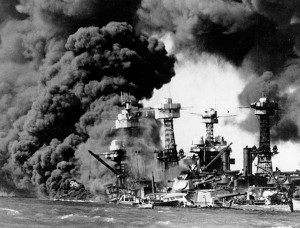
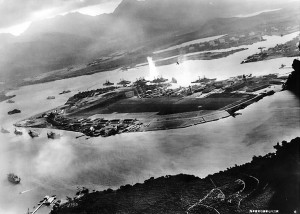 Located in the middle of Pearl Harbor is an island 335 acres in size. In Hawaii’s early days, it was known as Mokuumeume, meaning Island of Strife. It amazes me just how close that name is to the reality that is the island that is now known as Ford Island. I don’t think that strife is a constant companion of the island, but on this day, December 7, 1941…the date that will live in infamy, Ford Island was at center stage as one of the worst attacks in history took place on American soil. The participants, from the American side anyway, would have most certainly have chosen not to be there…if they had been given a choice. The island had changed hands several times, before finally ending up as a part of the military installation that was Pearl Harbor.
Located in the middle of Pearl Harbor is an island 335 acres in size. In Hawaii’s early days, it was known as Mokuumeume, meaning Island of Strife. It amazes me just how close that name is to the reality that is the island that is now known as Ford Island. I don’t think that strife is a constant companion of the island, but on this day, December 7, 1941…the date that will live in infamy, Ford Island was at center stage as one of the worst attacks in history took place on American soil. The participants, from the American side anyway, would have most certainly have chosen not to be there…if they had been given a choice. The island had changed hands several times, before finally ending up as a part of the military installation that was Pearl Harbor.
Every year, as Pearl Harbor Remembrance Day comes around, I try to write a story about that dreadful day, and this year, while looking at Pearl Harbor on Google Earth, my thoughts turned to that little island that was at the center of the attack. How must those men have felt? Everything happened so fast. There wasn’t even time to get the planes in the air. While the ships were being bombed around them, the pilots, mechanics, and airfield crew could only stand around watching…and dodging bullets. Of course, for most of them, that was impossible. The death toll that horrific day was 2403. In addition, there were 1178 people wounded. The emotional toll was beyond the imagination. This was the event that finally brought the United States into World War II.
I began to wonder what the people who were there were thinking as the events of the attack unfolded. There was no way to get off the island. If they had tried, they would surely have been killed. There were bombs going off on all sides of the island. Ships were sinking, airplanes were destroyed, and buildings were on fire or blown up. It was as if the world was coming to an end…or in reality, it was like waking up and finding yourself literally in Hell. My mind struggled to imagine how they must have felt…wishing and praying that all this was a dream and that they could be somewhere else…anywhere else. Still, they knew that it was real, and they were there, and 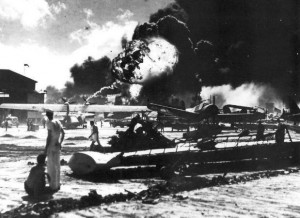
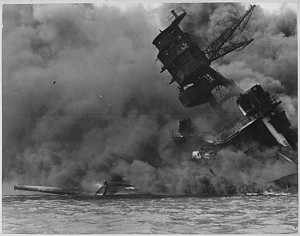 nothing would ever be the same again. They knew that the world as they had known it, had vanished…never to exist again. Of course, our country would come back from this attack, because we are a resilient people, but we would never be the same. We were less trusting of our enemies, something I see again in this day and age of terrorism, and something I think is important.
nothing would ever be the same again. They knew that the world as they had known it, had vanished…never to exist again. Of course, our country would come back from this attack, because we are a resilient people, but we would never be the same. We were less trusting of our enemies, something I see again in this day and age of terrorism, and something I think is important.
Being too trusting of our enemies in December of 1941, was exactly what paved the way for a surprise attack on December 7, 1941, and being too trusting today could do the same thing. It is imperative that we protect our people at all costs…even if it makes us seem heartless now. As in the case of the attack on Pearl Harbor, second chances at protecting our people don’t usually come. By the time we realize that we have made a mistake, it is too late, because it has become a fatal mistake. The men and women who survived the attack on Pearl Harbor knew first hand that our enemies hate us and want nothing less that death for America. That, I believe is the valuable lesson the people who survived that horrific attack took away that fateful day, and one we all need to seriously consider today.
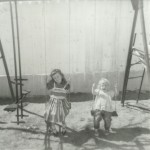 When I think back to my childhood, I always remember the carefree times. Summers spent with nothing but time on our hands, meant swimming at the Kelly Walsh pool, sunning in the back yard, and sack lunches eaten at the park, simply because it was something different to do. Of course, back then, you could easily send your kids to the park by themselves, and they could be gone for hours, and still you did not worry. That fact worked in our favor, because we were allowed to go so many places and do so many things on our own because the world was much safer than it is today.
When I think back to my childhood, I always remember the carefree times. Summers spent with nothing but time on our hands, meant swimming at the Kelly Walsh pool, sunning in the back yard, and sack lunches eaten at the park, simply because it was something different to do. Of course, back then, you could easily send your kids to the park by themselves, and they could be gone for hours, and still you did not worry. That fact worked in our favor, because we were allowed to go so many places and do so many things on our own because the world was much safer than it is today.
I remember the hours we spent at the school…the very place we couldn’t wait to get away from while school was still in session. Of course, we weren’t there for the  classroom, but rather for the playground. Just a couple of months earlier, we couldn’t wait for summer to come, because we were determined not to go anywhere near that school…oh well, the best laid plans…right? Nevertheless, just as soon as you got to those swings that were so very different from the ones at home, you knew that coming to the school in the summertime was a totally different thing, and very much acceptable. It didn’t even matter if you had to bring your little sister along, and going to the park was totally ok even if your parents had to come along. Somehow, even having that parental supervision couldn’t dampen your spirits.
classroom, but rather for the playground. Just a couple of months earlier, we couldn’t wait for summer to come, because we were determined not to go anywhere near that school…oh well, the best laid plans…right? Nevertheless, just as soon as you got to those swings that were so very different from the ones at home, you knew that coming to the school in the summertime was a totally different thing, and very much acceptable. It didn’t even matter if you had to bring your little sister along, and going to the park was totally ok even if your parents had to come along. Somehow, even having that parental supervision couldn’t dampen your spirits.
I’m not sure why these thoughts of summer vacation came to my mind today, other than perhaps the upcoming Christmas vacation, which is definitely a close second when it comes to the carefree days of vacation from school. I loved school, but there was just something about that break from school that always felt so 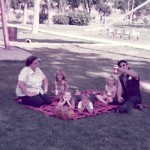 amazing. I just think every kid needs a break from school, even if they love it. There will always be time for kids to work every day for the rest of their lives, but summer vacation and Christmas break…well those are just pretty much for the kids, and of course their teachers, who I consider very blessed, by the way. I think most of us would love to have their summer vacations off. Nevertheless, that said, today found me thinking about the upcoming Christmas vacation that the kids will have, including two of my grandsons. It will be a welcome break from their studies, even if they do have to work at their jobs. To the kids, I say, enjoy those days while you can, because all too soon, the day will come when you too have a job and those long vacations are a thing of the past.
amazing. I just think every kid needs a break from school, even if they love it. There will always be time for kids to work every day for the rest of their lives, but summer vacation and Christmas break…well those are just pretty much for the kids, and of course their teachers, who I consider very blessed, by the way. I think most of us would love to have their summer vacations off. Nevertheless, that said, today found me thinking about the upcoming Christmas vacation that the kids will have, including two of my grandsons. It will be a welcome break from their studies, even if they do have to work at their jobs. To the kids, I say, enjoy those days while you can, because all too soon, the day will come when you too have a job and those long vacations are a thing of the past.
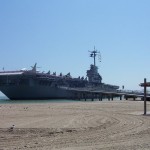 While Bob and I were in Corpus Christi, Texas in March of 2006, we had the opportunity to visit the USS Lexington, better known now, as The Blue Ghost. The ship was originally known as the Cabot, but after the USS Lexington CV-2 was lost in the Battle of the Coral Sea, she was renamed while under construction to commemorate the earlier USS Lexington. This Lexington was the fifth United States Navy ship to bear the name in honor of the Revolutionary War Battle of Lexington. In June of 1942, after the earlier USS Lexington was destroyed, workers at the shipyard submitted a request to Navy Secretary Frank Knox to change the name of a carrier currently under construction there to Lexington. Knox agreed to the proposal and Cabot was renamed as the fifth USS Lexington on 16 June 1942. She was launched on 23 September 1942, sponsored by Mrs Theodore Douglas Robinson. Lexington was commissioned on February 17, 1943.
While Bob and I were in Corpus Christi, Texas in March of 2006, we had the opportunity to visit the USS Lexington, better known now, as The Blue Ghost. The ship was originally known as the Cabot, but after the USS Lexington CV-2 was lost in the Battle of the Coral Sea, she was renamed while under construction to commemorate the earlier USS Lexington. This Lexington was the fifth United States Navy ship to bear the name in honor of the Revolutionary War Battle of Lexington. In June of 1942, after the earlier USS Lexington was destroyed, workers at the shipyard submitted a request to Navy Secretary Frank Knox to change the name of a carrier currently under construction there to Lexington. Knox agreed to the proposal and Cabot was renamed as the fifth USS Lexington on 16 June 1942. She was launched on 23 September 1942, sponsored by Mrs Theodore Douglas Robinson. Lexington was commissioned on February 17, 1943.
I can’t say for sure if this Frank Knox was any relation to my husband’s Knox ancestors, but it wouldn’t  surprise me at all, since the Knox family was into politics, and even included a connection to President James Knox Polk. While I was originally writing this because on this day, December 5, 1941, the prior USS Lexington headed out to the Battle of Midway…a battle that it never made it to, because of the Japanese attack on Pearl Harbor. That Lexington made it back to Pearl Harbor on December 13, 1941, so it was not much help. Later, the prior USS Lexington was destroyed in the Battle of Coral Sea, triggering the renaming of the USS Lexington that Bob and I saw.
surprise me at all, since the Knox family was into politics, and even included a connection to President James Knox Polk. While I was originally writing this because on this day, December 5, 1941, the prior USS Lexington headed out to the Battle of Midway…a battle that it never made it to, because of the Japanese attack on Pearl Harbor. That Lexington made it back to Pearl Harbor on December 13, 1941, so it was not much help. Later, the prior USS Lexington was destroyed in the Battle of Coral Sea, triggering the renaming of the USS Lexington that Bob and I saw.
The USS Lexington we saw was referred to as a “ghost” ship by the Japanese for her tendency to reappear after reportedly being sunk. This, coupled with the ship’s dark blue camouflage scheme, led the crew to refer to her as “The Blue Ghost”. There were rumors during the war that the ship was so badly damaged it had to be scuttled at one point, but a newly built aircraft carrier was immediately deployed with the same name, in an effort to demoralize the Japanese. I’m sure the whole situation was a serious frustration to the Japanese, but for Bob and me the legend that ship had 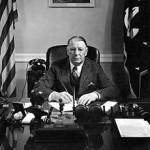 become was something we found quite interesting.
become was something we found quite interesting.
That said, I now find something new to draw my interest…namely Navy Secretary Frank Knox. One thing I have noticed is that in many families, certain names seem to be used over and over. In Bob’s family, there is a Frank Knox, and in that lineage there are Williams and Johns. The same is the case with Navy Secretary Frank Knox’s lineage. For that reason, I expect that a connection exists, and with a little work, I think I will find it, if it exists. I like the challenges that come from trying to connect the missing links in our family, and when I can tie it to something I have personally seen, it is an even more exciting quest.
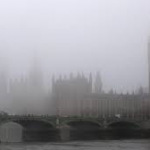 When we think of disasters, we seldom think of smog, but on December 4, 1952 in London, England, smog caused a disaster of epic proportions. On that day, a high pressure system stalled over the Thames River Valley, causing the smog to hang over the area for four days. The air over London became trapped, and along with it, the smog. We have lived with smog in our world for a long time, and while we know it isn’t good for us, most of us consider it to be a minor annoyance, rather that anything serious. Nevertheless, on this day, December 4, 1952, the people of London, England found out that smog is not something to be taken lightly.
When we think of disasters, we seldom think of smog, but on December 4, 1952 in London, England, smog caused a disaster of epic proportions. On that day, a high pressure system stalled over the Thames River Valley, causing the smog to hang over the area for four days. The air over London became trapped, and along with it, the smog. We have lived with smog in our world for a long time, and while we know it isn’t good for us, most of us consider it to be a minor annoyance, rather that anything serious. Nevertheless, on this day, December 4, 1952, the people of London, England found out that smog is not something to be taken lightly.
Because of the cold air in the area, many people burned extra coal in their furnaces to keep warm, making the problem worse. The smoke, soot, and sulfur dioxide from the area’s industries along with that of cars and energy use by the people caused heavy smog to blanket the city. By the 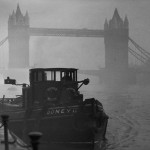 morning of December 5th there was the smog made it difficult to see for hundreds of square miles.
morning of December 5th there was the smog made it difficult to see for hundreds of square miles.
By December 7th, the smog was so thick that it blocked out the sunlight and visibility was reduced to five yards. Transportation in the region was halted when the smog caused several rail accidents, including a collision between two trains on the London Bridge. The biggest problem, however, came from the respiratory distress it caused to both humans and animals, including difficulty breathing and coughing up phlegm. One of the first victims was a prized cow that suffocated on December 5th. Suddenly, people were dying in their sleep over the weekend…thousands in fact. The exact number of victims is not known, but has been estimated between 4,000 and 8,000.
I first heard about this unbelievable situation while watching the weather channel a while back. I knew that the 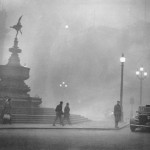 weather in London had been known to cause some problems, but the main one was when heavy fog would blanket the city. That was something that made England a tough area to fly in during World War II, and was also one of the reasons why B-17 Bomber crews were allowed to fly less missions before being released to go home. They figured that if they made it through the fog successfully, they deserved to get to go home. Nevertheless, I would never have expected that smog would cause so much death, but on December 4, 1952, when a freak high pressure system locked down the air over London, England, holding the smog tightly in place, that is exactly what happened. I don’t know if any of my relatives were among the victims or not, but since my family does come from England, I would not be surprised.
weather in London had been known to cause some problems, but the main one was when heavy fog would blanket the city. That was something that made England a tough area to fly in during World War II, and was also one of the reasons why B-17 Bomber crews were allowed to fly less missions before being released to go home. They figured that if they made it through the fog successfully, they deserved to get to go home. Nevertheless, I would never have expected that smog would cause so much death, but on December 4, 1952, when a freak high pressure system locked down the air over London, England, holding the smog tightly in place, that is exactly what happened. I don’t know if any of my relatives were among the victims or not, but since my family does come from England, I would not be surprised.
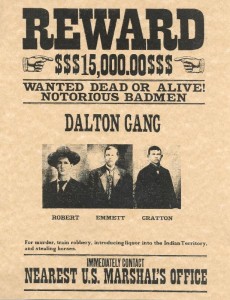
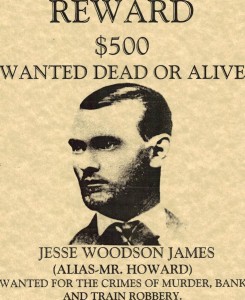 As the railroad spread across this land, and payrolls began coming in by way of the railroad, a new breed of criminal showed up on the scene…the train robbers. At first, the train robbers got away with it, because no one had really given much thought to the possibility of such a thing happening. Gangs like Jesse James…who was best known as a bank robber, but was also one of the early train robbers, Butch Cassidy and the Wild Bunch, the Dalton Gang, and the Reno Gang terrorized the railways, stealing the payrolls of crews working on building the railroads and towns in the west.
As the railroad spread across this land, and payrolls began coming in by way of the railroad, a new breed of criminal showed up on the scene…the train robbers. At first, the train robbers got away with it, because no one had really given much thought to the possibility of such a thing happening. Gangs like Jesse James…who was best known as a bank robber, but was also one of the early train robbers, Butch Cassidy and the Wild Bunch, the Dalton Gang, and the Reno Gang terrorized the railways, stealing the payrolls of crews working on building the railroads and towns in the west.
With the advent of train robberies came a need for a solution. Enter the train police. At first the railroads would arrange for a posse to go after the robbers, but eventually they realized that the posse was too little too late. They had to take affirmative action. So they put the police on the train with the money. I’m sure that more violence came from that action, but the robbers probably didn’t get away with it as often as they had been.
I think that in many ways, we have almost romanticized the train robbers, but in reality, they were like any other criminal. They would kill for the money they were after. The police were under as much pressure as the police these days. You can’t face a gun as a regular part of your job and not have some degree of fear for your life. These men were the law, and they were pretty much on their own. They couldn’t call in the state police, or the police from the next town over. Those were too far away…especially with the distances the trains traveled. The railroad police were the only thing standing between the robbers and the money.
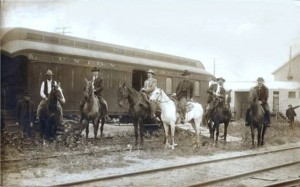
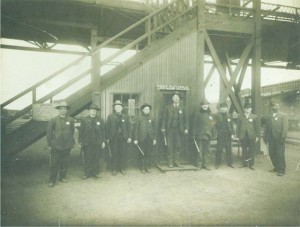 Theirs was an important job too. Every time the train was robbed, peoples lives were affected. Without the payroll money, the workers couldn’t support their families, and that caused more problems. The workers were angry and then desperate. I don’t think police work would be for me, but I have to wonder if police work was harder back in the old west, or now, with the terrorism and gang issues…or if police work is police work, no matter what era it is.
Theirs was an important job too. Every time the train was robbed, peoples lives were affected. Without the payroll money, the workers couldn’t support their families, and that caused more problems. The workers were angry and then desperate. I don’t think police work would be for me, but I have to wonder if police work was harder back in the old west, or now, with the terrorism and gang issues…or if police work is police work, no matter what era it is.
 Since my dad was stationed in England during World War II, and because many of my ancestors come from England, I am interested in all things English. Of course, that doesn’t mean that I know everything about England, and I think it would be pretty difficult to do that with any country, including the country I live in…the United States. That said, I learned something about England today. England is an island nation as most people know, and that can make travel to mainland Europe difficult and expensive. Travel to Hawaii would be a good example of that, and Hawaii isn’t even it’s own nation. Nevertheless, most of us have to save up our money to make the trip to Hawaii.
Since my dad was stationed in England during World War II, and because many of my ancestors come from England, I am interested in all things English. Of course, that doesn’t mean that I know everything about England, and I think it would be pretty difficult to do that with any country, including the country I live in…the United States. That said, I learned something about England today. England is an island nation as most people know, and that can make travel to mainland Europe difficult and expensive. Travel to Hawaii would be a good example of that, and Hawaii isn’t even it’s own nation. Nevertheless, most of us have to save up our money to make the trip to Hawaii.
So, what does that have to do with England, you might ask. Well…everything. While an alternate mode of transportation to get to Hawaii…other than ship or plane, is not feasible for Hawaii…for England, maybe it could be. As early as the days of Napoleon Bonaparte, in 1802, people were looking for a way to connect England to France. Nothing came of those early suggestions, because the necessary technology was not available until the 20th century. The proposal was that since England and France were no longer at war, they should permanently connect their countries by way of a tunnel. The Channel Tunnel, later dubbed the Chunnel runs from Folkestone, England to Calais, France. The tunnel is 31 miles across, but in total there are 95 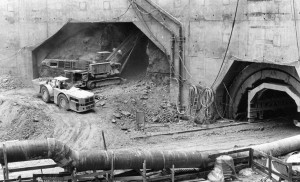 miles of tunnels. There are two railway tunnels, and a service tunnel. The work began on in 1986, and took four years to connect the two sides. Approximately 13,000 workers dug the 95 miles of tunnels at an average depth of 150 feet below sea level. Eight million cubic meters of soil were removed, at a rate of about 2,400 tons per hour. When it was finished, the Chunnel would have three interconnected tubes, including one rail track in each direction and one service tunnel. It cost $15 billion to complete.
miles of tunnels. There are two railway tunnels, and a service tunnel. The work began on in 1986, and took four years to connect the two sides. Approximately 13,000 workers dug the 95 miles of tunnels at an average depth of 150 feet below sea level. Eight million cubic meters of soil were removed, at a rate of about 2,400 tons per hour. When it was finished, the Chunnel would have three interconnected tubes, including one rail track in each direction and one service tunnel. It cost $15 billion to complete.
Most of us don’t give much thought to tunnels, but when it comes to underwater tunnels…well, that is just different. Of course, we all know of the Holland Tunnel that connects New York and New Jersey, but that tunnel isn’t nearly as long as the Chunnel. The Holland Tunnel is a little over a mile and a half, which pales by comparison to the Chunnel’s 31 miles. On December 1, 1990, after four long years of work, the two sides of the Chunnel were connected. Workers exchanged French and British flags and toasted each other with champagne. It was a great day. The Channel Tunnel finally opened for passenger service on May 6, 1994, with Britain’s Queen Elizabeth II and France’s President Francois Mitterrand on hand in Calais for the inaugural run. A company called Eurotunnel won the 55 year contract to operate the Chunnel, which is the crucial stretch of the  Eurostar high speed rail link between London and Paris. The regular shuttle train through the tunnel runs 31 miles in total, with 23 of those underwater and it takes 20 minutes, with an additional 15 minute loop to turn the train around. The Chunnel is the second-longest rail tunnel in the world, after the Seikan Tunnel in Japan.
Eurostar high speed rail link between London and Paris. The regular shuttle train through the tunnel runs 31 miles in total, with 23 of those underwater and it takes 20 minutes, with an additional 15 minute loop to turn the train around. The Chunnel is the second-longest rail tunnel in the world, after the Seikan Tunnel in Japan.
Things like this fascinate me. I like the idea of something as unique as the Chunnel. I like the interesting fact that it is in England. And I like the fact that, the Chunnel is the longest underwater section, longest international tunnel, second-longest railway tunnel in the world. Some day, I hope to ride the train through that tunnel. Wouldn’t that be amazing?
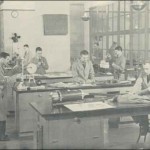 In years gone by, criminal investigations were often flawed, circumstantial, or non-existent. If the crime wasn’t witnessed by someone, it often didn’t get solved, unless someone had threatened to kill someone. Even then, the wrong person was convicted quite often…probably not often than anyone cared to admit or think about. It was a fact that no one really wanted to think about. Then, as science began to find new ways to process
In years gone by, criminal investigations were often flawed, circumstantial, or non-existent. If the crime wasn’t witnessed by someone, it often didn’t get solved, unless someone had threatened to kill someone. Even then, the wrong person was convicted quite often…probably not often than anyone cared to admit or think about. It was a fact that no one really wanted to think about. Then, as science began to find new ways to process 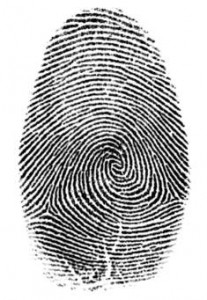 evidence, there were fewer mistakes. That didn’t and still doesn’t completely eliminate miscarriages in justice, but more and more often, the right person is sentenced.
evidence, there were fewer mistakes. That didn’t and still doesn’t completely eliminate miscarriages in justice, but more and more often, the right person is sentenced.
There are a number of television shows on these days that feature the use of a crime lab, and while I realize that the investigations rarely progress as quickly as they do on television, I do find them interesting nevertheless. I don’t know how realistic some of the tests are, but I have a feeling that the answer is…not very. Nevertheless, I like the idea of using science to catch the right criminal. Things like fingerprints, DNA testing, ballistics, and the chemical makeup of poisons, to name a few, are tests that have revolutionized the criminal justice system. 
It was on this day, November 24, 1932, that the first FBI Crime Lab opened, and while it has gone through some controversy over the years, it still remains on of the best labs in the country. The crime lab is now known as the FBI Scientific Crime Detection Laboratory. Originally this lab was chosen because it has the necessary sink operated out of a single room and only one employee. It has expanded exponentially since then. Of course, these days each state has their own lab too, and while there has been controversy as to bias over the years, those operate in much the same way. Scientific answers to serious questions. And it all started in a single room, rather primitive lab in 1932.
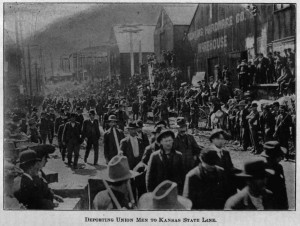 I think a lot of people know or at least have heard of Cripple Creek, Colorado. Most people think of the fourteen casinos located there, and I suppose that casinos are a fitting thing for Cripple Creek to be known for, but it wasn’t always that way. Cripple Creek became a gold mining boom town in 1894 after gold was discovered there. At that time 150 gold mines suddenly sprang up, and with them, a strong miners union…the Free Coinage Union Number 19, which was a part of the militant Western Federation of Miners.
I think a lot of people know or at least have heard of Cripple Creek, Colorado. Most people think of the fourteen casinos located there, and I suppose that casinos are a fitting thing for Cripple Creek to be known for, but it wasn’t always that way. Cripple Creek became a gold mining boom town in 1894 after gold was discovered there. At that time 150 gold mines suddenly sprang up, and with them, a strong miners union…the Free Coinage Union Number 19, which was a part of the militant Western Federation of Miners.
As with any gold mining operation, desparate workers began pouring in from all over the country. Before long Cripple Creek had a huge labor surplus. With the labor surplus, the owners begin requiring extra hours, with no pay increase, or the alternative, they could keep the current 8 hours a day with a pay reduction of 50 cents. The Western Federation of Miners opposed both plans, and the miners when on strike. Their picket lines and refusal to work closed most of the mines. They showed what solidarity is all about. The miners who were still going down in the 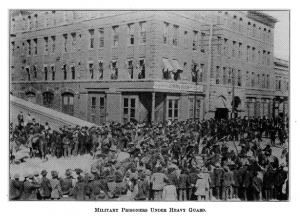 working mines assessed themselves 10 percent of their wages to support the strikers, and the union set up soup kitchens. How often to you see people who can’t afford to strike, but who are willing to support those who do strike.
working mines assessed themselves 10 percent of their wages to support the strikers, and the union set up soup kitchens. How often to you see people who can’t afford to strike, but who are willing to support those who do strike.
The governer of Colorado, David Waite would not help the labor bosses, but they had the county Sheriff, Frank Bowers in their pocket. They told the miners to go back to work, they would not. By the end of October, things had gotten so out of hand that finally, on November 23, 1903, Governor Peabody agreed to send the state miltia to protect replacement workers that the bosses had brought in. The striking miners were furious and they barricaded the roads and railways. The soldiers began rounding up the union members and their sympathizers, including the entire staff of a pro-union newspaper, and imprisoned them without charges or any evidence that they had done anything wrong.
The miners and others who were imprisoned complained that their constitutional rights had been violated, and 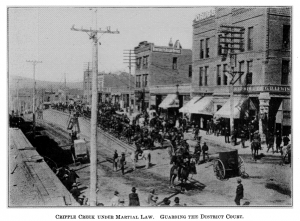
one anti-union judge replied, “To hell with the Constitution; we’re not following the Constitution!” Those tactics brought out the more radical elements of the Western Federation of Miners, and in June of 1904 Harry Orchard, who was a professional terrorist the the union employed, blew up a railroad station, whick killed 13 strikebreakers. With the bombing came the outrage of the public and the deportation of the Western Federation of Miners leaders. By midsummer, the strike was over and the Western Federation of Miners never regained the same level of power it had originally had in the Colorado mining districts. Even in this day and age, the unions and the bosses seem to always be at odds, and I suppose that something like this could happen again.
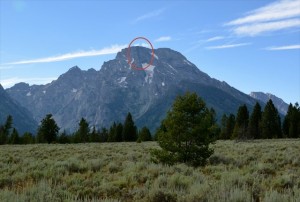 When I was about 10 years old or so, my family and my Uncle Bill’s family went to the Jackson, Wyoming area. While we were stopped at a lookout point for the Teton Mountains, my dad told a story, or maybe read the story about a plane that had crashed on Mount Moran on November 21, 1950. He told us that because of the difficulty in reaching the site, the plane and the remains of the 21 people lost in the crash were never removed from the site. My young mind could not seem to get past the fact that those bodies were still on that mountain top. I had a terrible time sleeping. I don’t know if I felt like we were somehow camping someplace we shouldn’t be, which was silly, because that site was miles from where we were camped. Nevertheless, it bothered me very much at that time. Now, many years later, I would know that the mountain was simply a burial place for the victims of a tragic crash.
When I was about 10 years old or so, my family and my Uncle Bill’s family went to the Jackson, Wyoming area. While we were stopped at a lookout point for the Teton Mountains, my dad told a story, or maybe read the story about a plane that had crashed on Mount Moran on November 21, 1950. He told us that because of the difficulty in reaching the site, the plane and the remains of the 21 people lost in the crash were never removed from the site. My young mind could not seem to get past the fact that those bodies were still on that mountain top. I had a terrible time sleeping. I don’t know if I felt like we were somehow camping someplace we shouldn’t be, which was silly, because that site was miles from where we were camped. Nevertheless, it bothered me very much at that time. Now, many years later, I would know that the mountain was simply a burial place for the victims of a tragic crash.
While I am no longer haunted by the thought of those lost ones buried in the ice at the top of the mountain, I really never lost my curiosity about the crash and just who those people were. Then, a few weeks ago, I found that today would be the 65th anniversary of that crash. It seemed like it was time to find out more about it. The plane, a new Douglas DC-3, was owned by New Tribes Mission. It was on the first leg of a trip to South America. It left Chico, California and was bound for Billings, Montana. The last radio report in was over Idaho Falls, Idaho at 3:48pm. Then it was reported overdue at Billings, leaving the sinking feeling that something tragic had happened. A resort owner said he saw a burning fuselage in the flames far above timberline on the east face of Mount Moran. When the fire subsided, he could see nothing resembling a campfire, which might have indicated survivors. Gaining access to the site was going to prove extremely difficult, and with temperatures seriously low, the chance of anyone making it through that first night were next to none. Of course, you can guess the outcome of the crash. All those on board were lost.
Removing the wreckage and the bodies of the victims proved to be a very difficult, if not impossible task, and in the end, it was decided that the wreckage and the remains would be left on the mountain. The crash site is just north of the top of the handle of Skillet Glacier. Sometimes a glint of the wreckage can be seen to this day on a sunny summer afternoon when the light is just right. The crash site remains a resting place for those lost souls, and hikers who pass the site are expected to show their respect by leaving this mountain gravesite undisturbed. The site is the burial ground for the ten men, four women, and seven children who’s remains are still entombed in the wreckage. I suppose that these days, while the plane might have been left on the mountain, the remains of the victims would have most certainly been removed allowing the families to give them a proper burial.
Hikers who have passed the wreckage have said that it has an eerie feeling. I’m sure it has to do with being so close to the remains of the victims of that horrible crash. I can totally relate to how they felt, because on that day, when we were camping just within sight of the mountain where the wreckage and the victims still remained, I could not sleep. I was not afraid of being haunted or anything silly like that, but rather I guess it felt like I was an intruder, much like the Native Americans felt when the White Man went through their burial grounds. It was just not the right place to be. I think I would feel even more like I was in the wrong place, if I ever hiked that mountain, and came upon that sight. I still have an eerie feeling about it to this day…or maybe it is just a sadness for those lost ones. I’m still not sure about that…to this day.
 I don’t know about your family, but in my family, there are a number of “die hard” football fans. Basically the situation is this. If their team is playing, don’t walk in front of the television, unless it is a commercial. Now my husband, Bob Schulenberg and I are definitely “die hard” Broncos fans, but we don’t always watch the game. I suppose lots of people would say that if we don’t watch the games, we aren’t “die hard” fans, but I say we are. You will never see me going for another team if they are playing my Broncos. I will root for my kids teams, as long as they are not playing the Broncos. That’s just the way it is. Now, in our house, there is no big football fight, because both Bob and I agree that the Broncos are our team, but our kids have homes that are in football division, making game day a little more heated. Nevertheless, I doubt if game day was ever quite as heated in my kids houses as it was with the Heidi Bowl. For many of you, I’m sure that a question has now arisen…namely, “What is the Heidi Bowl?” In fact, I’m sure that many of you are wondering if I know anything about football at all. True enough, there are a number of Bowl games played, with the ultimate one being the Super Bowl, and yes, I do know about football, and I assure you that the Heidi Bowl did exist.
I don’t know about your family, but in my family, there are a number of “die hard” football fans. Basically the situation is this. If their team is playing, don’t walk in front of the television, unless it is a commercial. Now my husband, Bob Schulenberg and I are definitely “die hard” Broncos fans, but we don’t always watch the game. I suppose lots of people would say that if we don’t watch the games, we aren’t “die hard” fans, but I say we are. You will never see me going for another team if they are playing my Broncos. I will root for my kids teams, as long as they are not playing the Broncos. That’s just the way it is. Now, in our house, there is no big football fight, because both Bob and I agree that the Broncos are our team, but our kids have homes that are in football division, making game day a little more heated. Nevertheless, I doubt if game day was ever quite as heated in my kids houses as it was with the Heidi Bowl. For many of you, I’m sure that a question has now arisen…namely, “What is the Heidi Bowl?” In fact, I’m sure that many of you are wondering if I know anything about football at all. True enough, there are a number of Bowl games played, with the ultimate one being the Super Bowl, and yes, I do know about football, and I assure you that the Heidi Bowl did exist.
The Heidi Bowl was played on November 17, 1968. The two teams were the Oakland Raiders and the New York Jets. The game between the Jets and the Raiders was a classic nail biter. It featured two of the league’s best teams and 10 future Hall of Fame players. With a little more than a minute left to play, the Jets kicked a 26-yard field goal that gave them a 32-29 lead. After the New York kickoff, the Raiders returned the ball to their own 23-yard line. What happened after that will go down in football history. The Raiders quarterback Daryle Lamonica threw a 20 yard pass to halfback Charlie Smith. A facemask penalty moved the ball to the Jets’ 43 yard line, and on the next play, Lamonica passed again to Smith, who ran it all the way for a touchdown. The Raiders took the lead…32-36. Then the Jets fumbled the kickoff. Oakland’s Preston Ridlehuber managed to grab the ball and run it two yards for another touchdown. Oakland had scored twice in nine seconds, and the game was over. Oakland won…43-32.
I’m sure you are still wondering how this was called the Heidi Bowl. Well, I’ll tell you. At the point where the game had just 65 seconds left, NBC switched off the game and put on the movie, Heidi, which had been scheduled to start at that point. The Oakland Raiders came from behind to score two touchdowns in nine seconds. They beat the New York Jets…and no one saw it, because they’re watching the movie Heidi instead. So the only people who got to see the end of that intense game were the people in the stands. Viewers were outraged, and they complained so vehemently that network executives learned a lesson they’ll never forget. “Whatever you do,” one said, “you better not leave an NFL football game.” It didn’t matter what was scheduled…the game is played out. 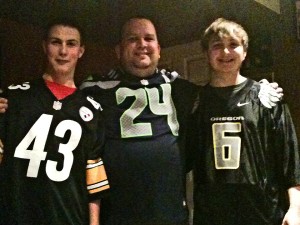
The Heidi Bowl was not a Bowl game that anyone, who loves football, ever wanted to watch, but it was one that was played, nevertheless. For anyone who doesn’t care about football, I’m sure that the thought was, “Oh for Pete’s sake, what is the problem?” Well, that was not the question for the NBC executives ever again. The problem is a huge one. Ratings!! If you want the ratings, don’t make such a big mistake as to jump out of a game 65 seconds before it’s over. Sure, most of the time there wouldn’t be much change, but you just never know…and if it does, you don’t want to deal with the aftermath.

